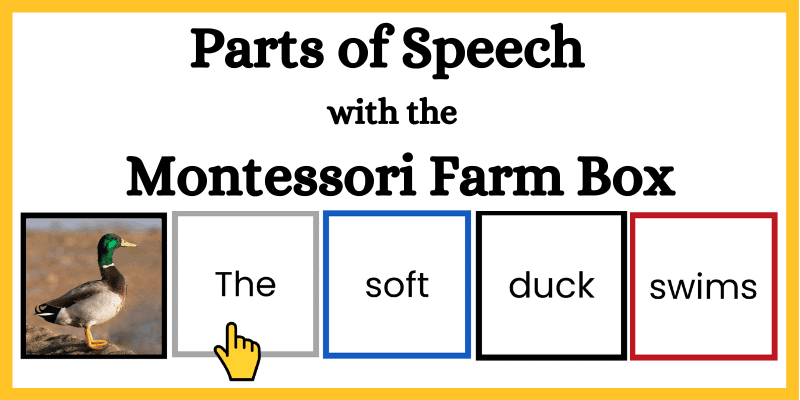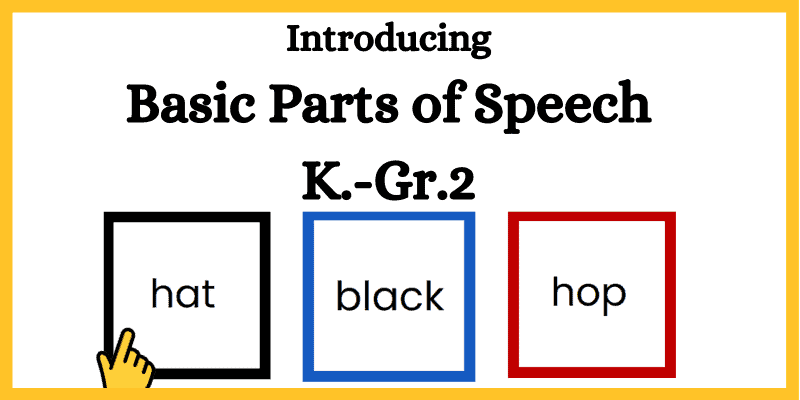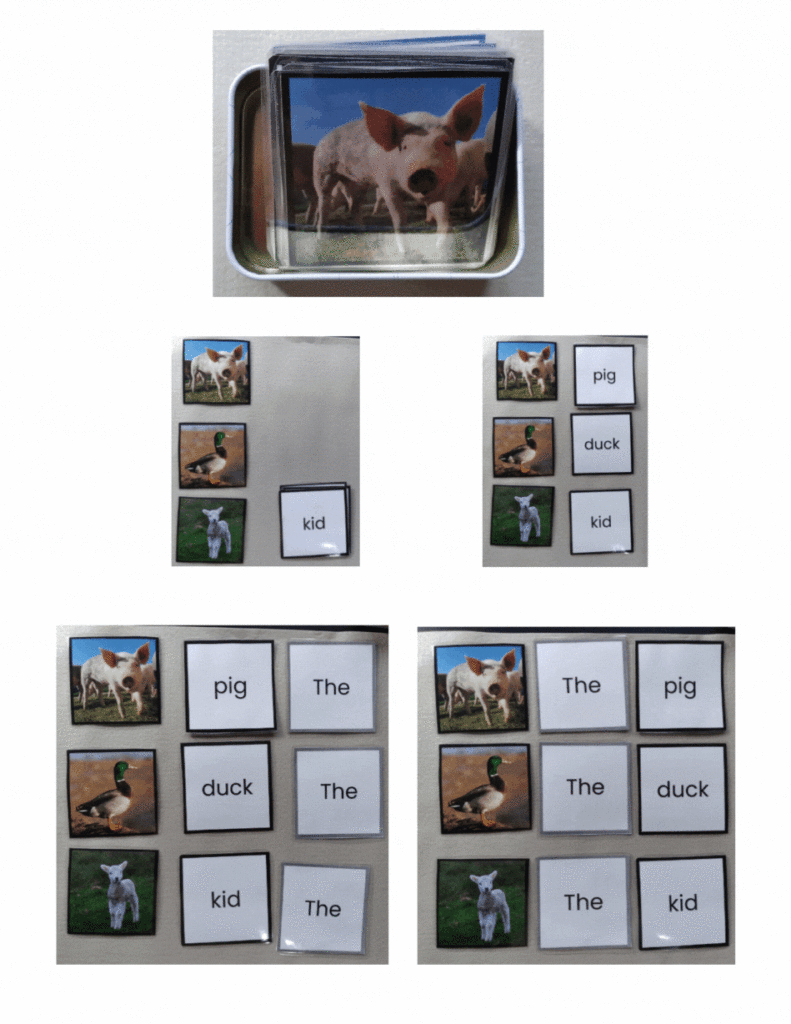Table of Contents
Learning the basic parts of speech is the essential first step in helping young children develop strong sentence structure and reading comprehension skills. In early literacy, even a simple sentence, phrase, or clause is built using four core parts of speech: article, noun, adjective, and verb. In this post, we’ll explore how to introduce nouns, verbs, and adjectives separately in a developmentally appropriate way for Kindergarten and Grade 1 students. Depending on your child’s reading level, you can adapt the activities using phonetic or non-phonetic words.
In the Montessori approach, parts of speech activities are beautifully color-coded, making it easier for children to recognize each word’s function. Nouns are black, articles are gray, verbs are red, and adjectives are blue. This visual system adds clarity and consistency, supporting both language development and independent learning.
Parts of Speech 1 – Nouns
A noun is a name of a person, place, or thing. This is the first part of speech to introduce to your learners. Start by making it meaningful—use objects from the child’s own environment. Seeing and touching the object helps make learning concrete.
In the classroom, ask children to look around and name the things they see. At home, encourage them to point out items around the house.
Here’s a fun, interactive way to teach the importance of naming:
Teacher: Ann, could you bring me an eraser, please.
Teacher: Mark, could you bring me a ruler, please
Teacher: Pam, could you bring me a _______
At this point, the child might ask, “Bring you what?” This opens a great discussion: if objects didn’t have names, we wouldn’t know how to ask for them. This is a simple and effective circle time activity to begin your grammar journey.
Nouns Activity 1 – Labeling the Classroom
In the Montessori method, noun cards are black. I use 3”x3” cards with a black border. Choose phonetic or non-phonetic classroom nouns based on your learners’ reading level.
Materials:
- Set of noun cards
- A small mat
- Classroom objects
Instructions:
- Lay a mat on the floor or table.
- Read a noun card together.
- Find the object in the classroom.
- Place the noun card beside or beneath the object (or on the mat if the object is too large or high up).
This is a hands-on way to build vocabulary and reinforce object recognition.
Nouns Activity 2 – Labeling Farm animals
Miniature animals or picture cards work perfectly for this activity. Make sure picture cards are uniform in size, so you can later use them for sentence-building work.
Instructions:
- Present a farm animal.
- Ask the child to find the correct noun label.
- Encourage phonetic decoding where possible.
Phonetic & Non-phonetic Noun Examples
| Phonetic Nouns Classroom Items | Non-phonetic Nouns Classroom Items | Phonetic Nouns Farm Animals | Non-phonetic Nouns Farm Animals |
| clock | chair | pig | horse |
| rug | table | hen | chick |
| blocks | pencil | ox | cow |
| desk | eraser | duck | sheep |
| box | globe | rabbit | goat |
Parts of Speech 2 – Adjectives
An adjective describes a noun. This is the second part of speech to introduce. Again, begin with your environment and familiar objects.
Try this fun interaction during circle time:
Teacher: Ann, could you bring me an eraser, please? (Ann brings a red eraser)
Teacher: No Ann, I don’t want a red eraser. I want a blue eraser, please. (Ann brings a blue eraser)
Teacher: Sorry Ann I don’t want a big blue eraser. I want a small blue eraser.
With each correction, children begin to understand how adjectives help us describe objects more clearly.
Phonetic & Non-phonetic Adjectives Examples
| Phonetic Adjectives | Non-phonetic Adjectives |
| big | small |
| red | blue |
| black | happy |
| sad | brave |
| mad | silly |
Parts of Speech 3 – Verb
A verb is an action word. In Montessori grammar, verbs are marked in red. These are so much fun to teach because they get children moving!
Start during circle time by inviting one child to read a verb card and perform the action. For example:
- jump
- clap
- hop
- run
Use a special red mat where children can do these actions. This sets a fun boundary and makes the experience feel intentional and engaging.
Phonetic & Non-Phonetic Verb Suggestions
| Phonetic Verbs | Non-Phonetic Verbs |
|---|---|
| hop, run, jump | dance, write, climb |
Bring It All Together – The Farm Box
Once children are familiar with nouns, adjectives, and verbs, it’s time to introduce the farm box—a Montessori classic. This is where children can build their own phrases and sentences using small animals, object cards, and word cards.
They can:
- Label animals (nouns)
- Describe them (adjectives)
- Show what they do (verbs)
It’s amazing to see their confidence and creativity bloom!
Tips for Success
- Keep it phonetic at first: Choose simple, CVC (consonant-vowel-consonant) words to build reading confidence.
- Use color coding consistently to help children visually categorize parts of speech.
- Repeat and review: Introduce parts of speech slowly and revisit them often through play and movement.
Looking Ahead
In Part 2, we’ll dive into the next parts of speech: articles and adverbs—and how to begin constructing full sentences with confidence and clarity.

Whether you’re teaching in a classroom or guiding your child at home, remember: learning parts of speech should feel fun, hands-on, and meaningful.
Back to School-8 Tips for a Smooth First Week of School
The Easiest way Teach Digraphs, Diphthongs, and Consonant Blends

